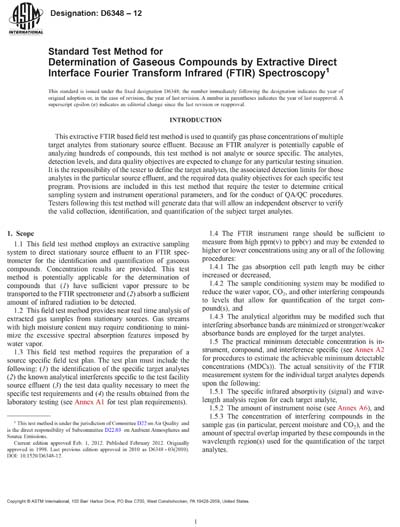Historical
ASTM D6348-12
Standard Test Method for Determination of Gaseous Compounds by Extractive Direct Interface Fourier Transform Infrared (FTIR) Spectroscopy
1.1 This field test method employs an extractive sampling system to direct stationary source effluent to an FTIR spectrometer for the identification and quantification of gaseous compounds. Concentration results are provided. This test method is potentially applicable for the determination of compounds that (1) have sufficient vapor pressure to be transported to the FTIR spectrometer and (2) absorb a sufficient amount of infrared radiation to be detected.
1.2 This field test method provides near real time analysis of extracted gas samples from stationary sources. Gas streams with high moisture content may require conditioning to minimize the excessive spectral absorption features imposed by water vapor.
1.3 This field test method requires the preparation of a source specific field test plan. The test plan must include the following: (1) the identification of the specific target analytes (2) the known analytical interferents specific to the test facility source effluent (3) the test data quality necessary to meet the specific test requirements and (4) the results obtained from the laboratory testing (see Annex A1 for test plan requirements).
1.4 The FTIR instrument range should be sufficient to measure from high ppm(v) to ppb(v) and may be extended to higher or lower concentrations using any or all of the following procedures:
1.4.1 The gas absorption cell path length may be either increased or decreased,
1.4.2 The sample conditioning system may be modified to reduce the water vapor, CO2, and other interfering compounds to levels that allow for quantification of the target compound(s), and
1.4.3 The analytical algorithm may be modified such that interfering absorbance bands are minimized or stronger/weaker absorbance bands are employed for the target analytes.
1.5 The practical minimum detectable concentration is instrument, compound, and interference specific (see Annex A2 for procedures to estimate the achievable minimum detectable concentrations (MDCs)). The actual sensitivity of the FTIR measurement system for the individual target analytes depends upon the following:
1.5.1 The specific infrared absorptivity (signal) and wavelength analysis region for each target analyte,
1.5.2 The amount of instrument noise (see Annex A6), and
1.5.3 The concentration of interfering compounds in the sample gas (in particular, percent moisture and CO2), and the amount of spectral overlap imparted by these compounds in the wavelength region(s) used for the quantification of the target analytes.
1.5.4 Any sampling system interferences such as adsorption or outgassing.
1.6 Practices E168 and E1252 are suggested for additional reading.
1.7 This standard does not purport to address all of the safety concerns associated with its use. It is the responsibility of the user of this standard to establish appropriate safety and health practices and to determine the applicability of regulatory limitations prior to use. Additional safety precautions are described in Section 9.
ASTM International [astm]

